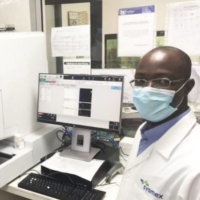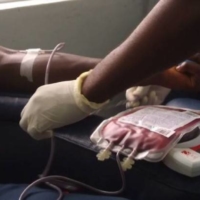Malaria has plagued mankind for thousands of years and remains a global health problem with billions of people at risk of contracting the disease. Children under the age of 5 in sub-Saharan Africa bear the brunt. Substantial gains in decreasing the global malaria burden over the past decade have recently been eroded, partly due to the COVID-19 pandemic, and the number of cases increased from 229 million to 241 million, resulting in 627,000 deaths in 2020, according to the latest report from the World Health Organization. WHO Director-General Tedros Ghebreyesus noted that “the critical 2020 milestones of WHO’s global malaria strategy have been missed, and without immediate and dramatic action, the 2030 targets will not be met.” Sysmex Corp. has joined the fight against malaria in Africa by introducing a new and innovative diagnostic tool, the automated hematology analyzer XN-31.

To understand what this advanced technology brings to the table, some background on malaria is useful and provides context. Malaria is caused by five species of Plasmodium parasites, which are transmitted to victims through the bite of infected female Anopheles mosquitos. The presence of parasites in the blood of a malaria patient was first discovered in 1880 by Alphonse Laveran, a French physician working in Algeria. In 1897 Ronald Ross, a British physician, identified the mosquito vector in India. Both seminal discoveries were rewarded with Nobel prizes. A third Nobel prize for research on malaria was awarded in 2015 to Youyou Tu from China for her discovery of artemisinin, the active ingredient in the sweet wormwood plant, Artemisia annua, which is the recommended treatment for malaria together with a partner drug. An effective vaccine has eluded scientists for more than 50 years, but a partially effective vaccine was approved by WHO in October 2021 for use in children living in highly endemic regions. In addition to the humanitarian toll, the disease has also had a major impact on our human genome through evolutionary pressure, resulting in the selection of defective disease-causing genes because they protect individuals from dying of malaria. Red blood cell disorders, such as sickle cell anemia, are thus the most common single gene disorders in the world today.

Despite the increased availability of diagnostic tests, such as microscopy, and curative drugs, malaria remains a killer. Its recent resurgence highlights the need for increased and multifaceted efforts, including new tools, to attain the goal of eliminating the disease. Renewed philanthropic interest, in particular the donation of $140 million over four years by the Bill and Melinda Gates Foundation, has underlined the sense of urgency. This was announced by Melinda Gates on June 23 at the Kigali Summit on Malaria and Neglected Tropical Diseases, which was attended by several African heads of state and health ministers. Sysmex Corp., based in Kobe, supports this effort with its automated hematology analyzer XN-31, which detects and accurately quantifies malaria parasites in the red blood cells of infected individuals and is superior to routine microscopy, as shown by several studies conducted in Africa and elsewhere.
In addition to supporting the diagnosis of malaria in the clinical context, one of the most promising settings for the XN-31 is in blood transfusion services in sub-Saharan Africa.
These services are essential, as encapsulated in the anonymous saying, “The tears of a mother can’t save her child, but your blood can.”
However, adults in malaria-endemic areas develop semi-immunity and may harbor parasites even though they are apparently healthy and can donate blood. Screening for malaria parasites is often not performed, either because the tests aren’t good enough or are too expensive.
A recent study at the Malawi Blood Transfusion Service using the XN-31 to screen donors concluded the analyzer is a powerful tool that would enhance transfusion safety and could provide valuable complementary surveillance data for malaria control.
Using the XN-31 to test donors for asymptomatic malaria parasitemia would serve multiple purposes.
First, it would improve the safety of blood transfusions by facilitating informed choices in allocating units to recipients. Pregnant women and young children, about half of whom receive blood transfusions to address malaria-induced anemia, are most vulnerable, and may be protected by transfusing them with malaria parasite-negative units or units with very low parasitemia to minimize the risk of transfusion-transmitted malaria. Second, blood donations are limited and data from the XN-31 will empower staff to maintain a balance between safety of transfusions and blood supply.

Additionally, each whole blood measurement on the XN-31 produces a concurrent complete blood count, and the hemoglobin level can be used as an indicator of anemia in the donor. Blood donors are heroes in the community and their health and safety are important. Finally, identification of the reservoir of asymptomatic carriers of malaria on a daily basis in real time will serve as an important additional and complementary surveillance tool to guide authorities in their malaria control programs. The importance of surveillance has been highlighted in the 2021 update of the WHO Global Technical Strategy for Malaria 2016-2030, where one of the three pillars of the strategy is to transform malaria surveillance into a key intervention.
In his preface to World Malaria Report 2021, Tedros stated that “although malaria has afflicted humanity for millennia, we have the tools and strategy now to save many lives — and with new tools, to start to dream of a malaria-free world.”
A malaria-free-world is but one of many goals Sysmex is pursuing in support of African development. As an example, Sysmex recently initiated a cross-industry co-creation project to improve maternal and child health and nutrition in the Republic of Ghana with The Ajinomoto Foundation (TAF) and NEC Corp.
In Ghana, malnutrition and malaria are serious health issues, and are considered the most significant risk factors for death and disability. Malnutrition is a leading factor in stunting the growth of unborn children and infants and also causes anemia, which enhances the risk of severe malaria. Additionally, children under 5 and pregnant women are especially vulnerable to malaria, making it particularly important to take an integrated approach to the prevention of malnutrition, anemia and malaria.

Since 2019, the World Food Programme and TAF have implemented activities with the Ghana Health Service (GHS), part of the Ministry of Health, to promote maternal behavior change and recommend the nutritional supplement Koko Plus as a specific solution to improving nutrition. By further developing this initiative and combining high-quality blood testing with information and communication technology from Japan, Sysmex will collaborate with NEC, TAF and GHS to accelerate activities aimed at improving maternal and child nutrition. Sysmex will contribute to this project by improving access to complete blood count and malaria testing utilizing XN-31. In addition, health system enhancement through educational activities for medical professionals would contribute to the early detection and treatment of anemia, malnutrition and malaria through human resources development, academic symposiums and other activities.
Yoshihide Hiruta, director of international cooperation at Sysmex, hopes that “companies from different industries can work together to work out a solution to maternal and child health issues, anemia and malaria through a comprehensive approach. … With tools like the XN-31, we can make a significant contribution to realize this dream, a malaria-free world.”










